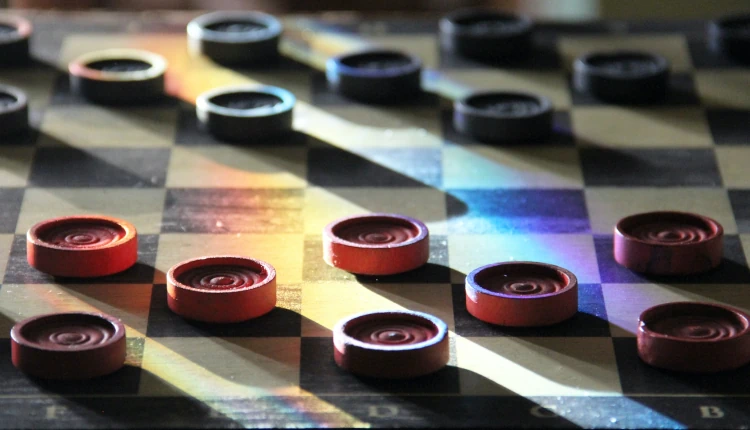Checkers: Mastering the Timeless Classic with Rules, Instructions & Strategy
For Chinese Checkers (aka. Sternhalma) see Chinese Checkers
Introduction
Checkers, also known as Draughts (pronounced like drafts) in some parts of the world, is a classic board game that has been enjoyed by people of all ages for centuries. I remember teaching this game to kids in the neighborhood using a giant set I bought from Walmart! Lovely memories from such an easy game to keep both adults and kids engaged and thinking. It is indeed a game of strategy, where two players compete to capture each other’s pieces and strive to be the last one standing on the board.

The game is played on a square board with 64 squares of alternating colors, typically black and white. Each player starts with 12 pieces, placed on the dark squares of the board. The objective of the game is to capture all of your opponent’s pieces or block them so they cannot make a move.
This classic game pits two players against each other in a battle of strategy and skill. The goal is to outwit the opponent by capturing their pieces, while simultaneously protecting your own. The ultimate aim is to either eliminate all of the opponent’s pieces from the board or block them in such a way that they have no legal moves left, thus rendering them unable to continue the game.
The game is played on a square board, which consists of 64 squares. These squares alternate between two colors, usually black and white, giving the board its distinctive checkered appearance. This design aids in gameplay as only the dark-colored squares are used for play.
Each player begins the game with 12 round pieces, also known as ‘men’. These pieces are arranged on the dark squares of the board, specifically, the first three rows closest to them. This initial setup leaves two central rows vacant, setting the stage for the strategic maneuvers and captures that will follow.
It is important to note that in Checkers, the pieces move diagonally, and can only occupy the dark squares. The pieces can capture an opponent’s piece by jumping over it to an unoccupied square beyond. If a player’s piece reaches the far edge of the board (the opponent’s side), it becomes a ‘King’ and gains the ability to move both forward and backward.
The game of Checkers requires careful planning and tactical foresight. A wrong move can leave a piece vulnerable to capture, shifting the balance of the game. The challenge lies in managing your pieces effectively, predicting your opponent’s moves, and responding with the best counter-strategy. Indeed, while the rules of Checkers are simple, the strategic possibilities are endless, making it a game that continues to captivate players worldwide.
Quick Tip to Win at Checkers
To win at checkers, focus on controlling the center of the game board to limit your opponent’s movements, always aim to keep your back row intact to prevent your opponent from getting kings, and make moves that force your opponent to make a mistake or leave their pieces vulnerable.
Rules for playing Checkers
- Checkers is played by two players, each starting with 12 pieces.
- The pieces are placed on the dark squares of the game board and move diagonally.
- If a player’s piece reaches the opposite side of the board, it becomes a “King” and can move both forward and backward.
- A player can capture an opponent’s piece by jumping over it to an empty square on the other side.
- If a player can make a capture, they must do so. If more than one capture is possible, the player can choose which to make.
- The game ends when one player captures all the opponent’s pieces or blocks them so they cannot move.
These are the official rules of Checkers, but many people play with variations or ‘house rules’. For example, some people play that if a player can make a capture, they must do so, while others allow the player to choose whether to make the capture or not.
How to Win at Checkers
Winning at Checkers requires strategic thinking and careful planning. Here are some strategies to help you win:
- Control the Center: The center of the board is a strategic position. By controlling the center, you can limit your opponent’s movements and make it easier for you to attack.
- Make Your Pieces Kings: Try to get your pieces to the other side of the board to make them Kings. Kings are powerful because they can move both forward and backward.
- Protect Your Pieces: Avoid leaving your pieces where they can be captured. Try to keep your pieces in pairs or groups so they can protect each other.
- Force Your Opponent to Make a Move: If you can force your opponent to make a certain move, you can set up a trap and capture their pieces.
Best Strategies for playing Checkers game
The best strategies for playing Checkers involve a combination of offense and defense. Here are some ways to approach a game of Checkers:
Offensive Strategy: This involves aggressively pursuing your opponent’s pieces and trying to capture them. This strategy can be effective, but it also leaves your pieces vulnerable to capture.
Defensive Strategy: This involves protecting your pieces and trying to avoid capture. This strategy can be effective, but it also makes it harder for you to capture your opponent’s pieces.
Balanced Strategy: This involves a combination of offense and defense. This strategy can be effective because it allows you to pursue your opponent’s pieces while also protecting your own.
Here are some more specific strategies to help you in a game of Checkers:
1. Control the Center: As in many other games, controlling the center of the board gives you an advantage. This allows your pieces to be more flexible and gives you more options in terms of movement and strategy.
2. Use Forced Moves to Your Advantage: In checkers, when an opponent’s piece is in a position to be jumped, you must make that move (unless you are playing with house rules where a player can decide not to capture). You can use this rule to your advantage by setting up situations where your opponent is forced to make a move that will benefit you.
3. Always Try to Keep a Back Row Guard: Keeping a piece or two in your back row can be a useful strategy. This prevents your opponent from getting their pieces ‘kinged’ and can save you in the later stages of the game.
4. Trade Pieces Wisely: Trade pieces only when it will give you an advantage. This could mean trading to gain positional advantage, to set up a trap, or to gain a material advantage (having more pieces than your opponent).
5. Keep Your Pieces Together: Try to keep your pieces in groups or ‘blocks’. This makes it harder for your opponent to jump your pieces and can help you control the board more effectively.
6. Use Kinged Pieces Effectively: Kinged pieces have the advantage of moving forwards and backwards. Use these pieces to control the game and to put pressure on your opponent.
7. Always Think Ahead: As with any strategy game, thinking ahead is crucial in checkers. Try to anticipate your opponent’s moves and plan your strategy accordingly. Always have a plan for your next move, and consider how your current move will impact the game down the line.
8. Avoid Making the First Jump: This might seem counter-intuitive, but making the first jump in a game of checkers can often put you at a disadvantage. This is because the player who jumps first often leaves themselves open to a double or triple jump with empty spaces behind their line.
9. Practice Patience: Checkers is a game of strategy and patience. Don’t rush your moves – take your time to consider all your options and choose the best one.
10. Learn from Your Mistakes: Every game of checkers is a learning opportunity. Whether you win or lose, analyze your game afterwards to see what worked, what didn’t, and what you can do differently next time.
Scenarios for Checkers
There are many different scenarios that can occur in a game of Checkers. Here are some common scenarios and how to handle them:
- You have more pieces than your opponent: In this scenario, you have an advantage and should try to maintain it. Be careful not to make careless moves that could allow your opponent to capture your pieces.
- Your opponent has more pieces than you: In this scenario, you are at a disadvantage and need to play defensively. Try to protect your pieces and make it difficult for your opponent to capture them.
- You have a King and your opponent does not: In this scenario, you have a significant advantage. Use your King to capture your opponent’s pieces and control the board.
- Your opponent has a King and you do not: In this scenario, you are at a significant disadvantage. Try to protect your pieces and make it difficult for your opponent’s King to capture them.
Frequently Asked Questions about playing Checkers game
Q: Can a piece move backwards? A: Only Kings can move backwards. Regular pieces can only move forward.
Q: Can a piece jump over its own piece? A: No, a piece can only jump over an opponent’s piece.
Q: Can a piece jump over more than one piece in a single move? A: Yes, if the jump leads to another jump, the piece can continue jumping.
Q: Can a piece become a King if it jumps to the last row? A: Yes, if a piece reaches the last row by jumping, it becomes a King.
Q: What happens if a player cannot make a move? A: If a player cannot make a move, they lose the game.
Additional Checkers Strategies
Here are some additional strategies to consider when playing Checkers:
- Try to control the corners of the board. This can limit your opponent’s movements and make it easier for you to capture their pieces.
- Try to keep your pieces on the dark squares. This can make it harder for your opponent to capture them.
- Try to force your opponent to make a move that will allow you to capture their pieces.
External Links
For more information about Checkers, visit the official game website USA Checkers.
Find Checkers reviews and ratings on BoardGameGeek.
Play Checkers online (no registration) at 247Checkers.
Title image by Leonard Reese

Eve Brownlee was a gamer before gaming communities on the internet were a thing. Eve grew up playing traditional, standard deck card games like Rummy and Bezique, taking an interest in the classics Backgammon and Chess. Parlor card games like Bridge continue to keep Eve active in the community. After a long career, primarily in horticulture for USDA in Maryland, Eve now travels and writes on The Pineapple (pineapples.info) and contributes to Quora/Pinterest topics. Contact Eve via email.



